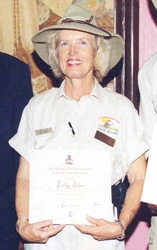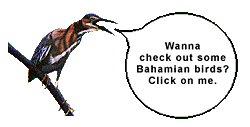| Excerpts from "Natives of The Bahamas (A Guide to Birds & Vegetation of Grand Bahama)" by Erika Moultrie. |
Adventures in Nature
Beaches
Bicycling
Bird
Watching
Dining
& Cuisine
Diving
Fishing
Gaming
Golf
Horseback Riding
Nightlife
Parasailing
Sailing
& Boating
Shopping
Snorkeling
Tennis
Windsurfing
Other
Activities
Bird-watching tours are available from birding guides certified by the Bahamas Ministry of Tourism. For more information, contact Kayak Nature Tours. |
Out of all the 700 islands and cays that make up The Islands of The Bahamas, Grand Bahama Island has the distinction of hosting the second highest number of native bird species. For birdwatchers and nature lovers, the island is a true mecca, a place where they can see 18 of the 28 species of Bahamian birds that are not seen in the U.S., Canada, or Europe.
The Rand Nature Centre, local headquarters of The Bahamas National Trust, is the perfect place for birders to start. It is home to West Indian flamingos, Antillean Peewee birds, Red-legged Thrushes, Stripe-headed Tanagers, and the endangered Bahama Parrot. The Centre maintains a small library with bird books and field guides and can provide information on other ideal birding spots.
Parrot Jungle's Garden of the Groves has many of the native specialties and, in season, many Neotropic migrants. West End is a true migrant trap, where more than thirty species of warblers and other migrants have been seen. Other sites vary from mangrove swamps, either accessible by boardwalk or kayak, to comfortable walking trails through the Caribbean pine forest (the dominant vegetation on the island), and other ecosystems -- the Whiteland Coppice, the Rocky Coppice, and the Blackland Coppice. And, of course, there are the beaches and the ponds on golf courses where native and migrating wading and water birds gather.
Owl Hole, one of the blue holes of the Lucayan Cave System leased by the Underwater Explorers Society (UNEXSO), is home to a family of barn owls. Diving is suspended when the owls are nesting there, usually between August and December.
Fall migrants can be seen in late September and October. Many of these species spend the winter on Grand Bahama Island and other islands of The Bahamas. There have been rare sightings of the Kirkland's Warbler and an Eastern Phoebe. Birds migrating north in the spring are best seen during March, April and May. The best time of year to see the permanent and summer resident species is the summer months.
HOME | THE ISLAND | NATURE
| HISTORY | PEOPLE | WHAT
TO DO |
|
This
page, and all contents of this Web site are Copyright |
|

